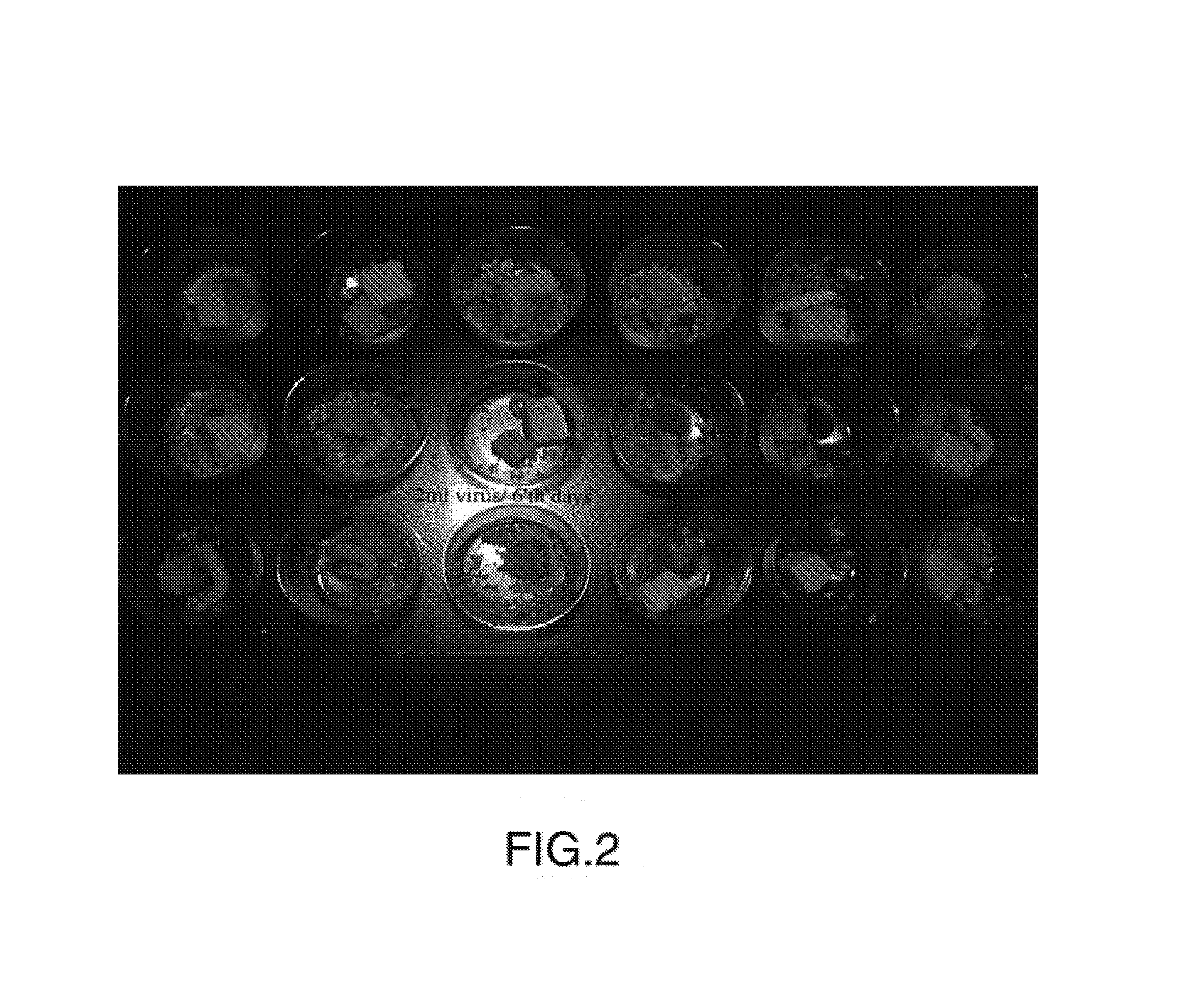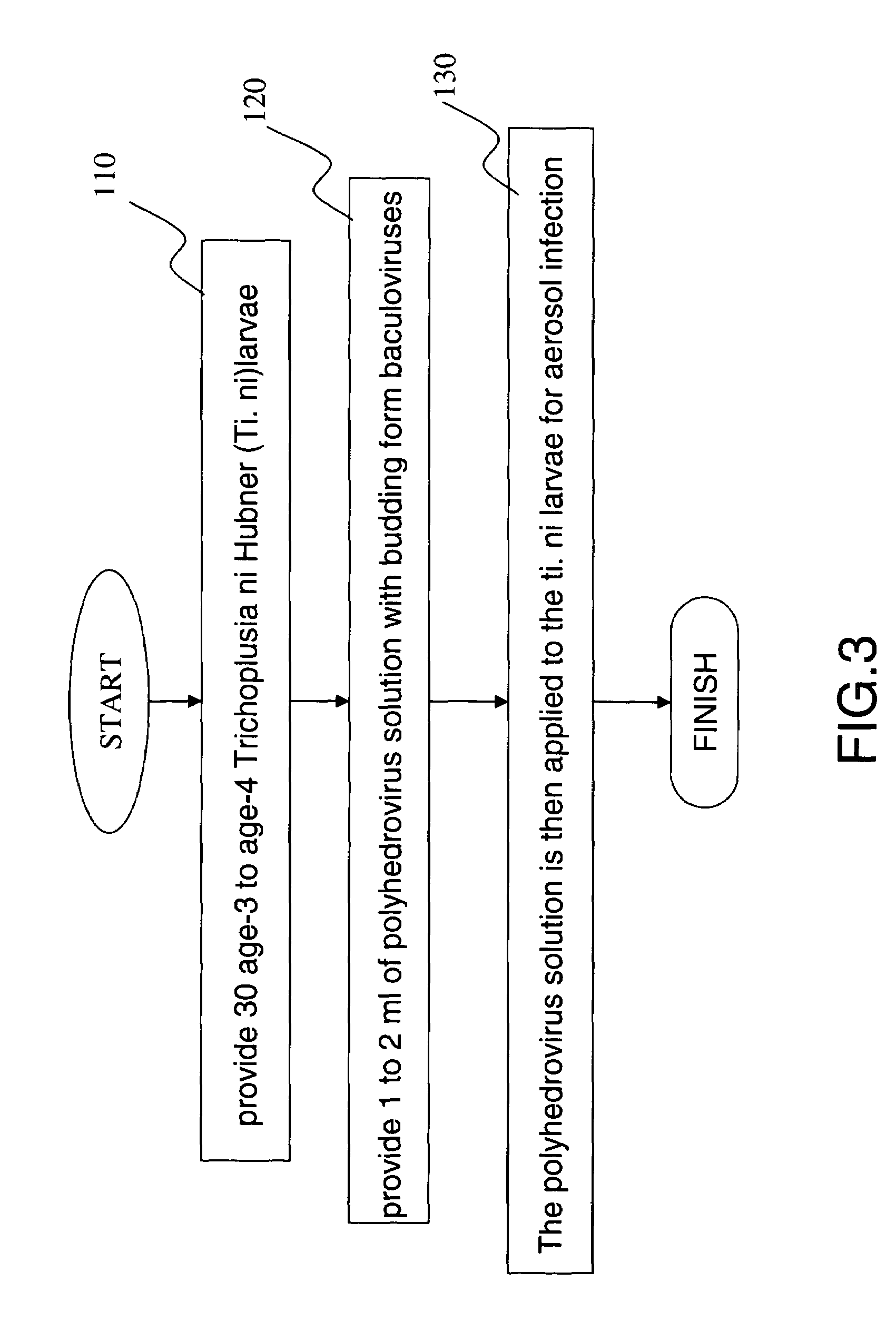Insect larva aerosol infection method for producing recombinant proteins and baculovirus bio-insecticides
a technology of baculovirus and aerosol, which is applied in the direction of biocide, genetic material ingredients, biochemistry apparatus and processes, etc., can solve the problems of reducing energy wasted in feeding infection, and the inability to determine which virus causes the successful infection, so as to reduce the cost of producing baculovirus and reduce the manpower needed for individual insect injection
- Summary
- Abstract
- Description
- Claims
- Application Information
AI Technical Summary
Benefits of technology
Problems solved by technology
Method used
Image
Examples
first embodiment
[0024]As shown in FIG. 3, the invention selects the Autographa californica nucleopolyhedrovirus (AcMNPV) as the source of the baculovirus aerosol. We provide 30 third-instsr T. ni larvae in step 110. We provide 1 to 2 ml of budding baculovirus solution in step 120. The polyhedrovirus solution is then applied to the T. ni larvae for aerosol infection in step 130. The virus solution used in the current embodiment can have a titer of 107 to 109 pfu (plaque formation unit) / ml.
[0025]Baculovirus has some nonessential genes, such as the polyhedrin gene or P10 gene. It does not matter if viruses do not have these genes because the replication and growing of viruses inside the insect cells are not affected. This can be used to form recombinant viruses with foreign genes, which are useful in identifying infection conditions or producing recombinant proteins.
[0026]In order to identify the infection conditions of the T. ni larvae and to ensure that the aerosol infection is achieved through the ...
second embodiment
[0033]The disclosed embodiment can be applied in bio-insecticide productions. A second embodiment is shown in FIG. 4. After step 110 through step 130 are completed, the viruses generated by the T. ni larvae infected with baculovirus are collected (step 140).
third embodiment
[0034]Moreover, after the recombinant viruses infect cells or larvae, they undergo replication, transcription, and translation inside the cells or larvae, mass-producing recombinant proteins. The flowchart of a third embodiment is shown in FIG. 4. First, steps 110 through 130 are performed. After the aerosol infection is done, the recombinant proteins produced by the T. ni larvae infected by the recombinant baculovirus are collected (step 150). The AcMNPV polyhedron promoter used herein is a strong promoter. Seventy-two hours after the recombinant viruses infect the insect cells; the recombinant protein concentration can reach more than 30% of all cell proteins. It is far higher than E. coli, yeast (1˜10%) or mammal cells (1%).
[0035]We further compare the infection rates of the aerosol infection and the conventional injection or feeding method. The dose of the injection method is 4 μl virus solution for each larva. The pollution does on the food surface is 1 ml virus solution. The a...
PUM
| Property | Measurement | Unit |
|---|---|---|
| genome size | aaaaa | aaaaa |
| cell splitting time | aaaaa | aaaaa |
| time | aaaaa | aaaaa |
Abstract
Description
Claims
Application Information
 Login to View More
Login to View More - R&D
- Intellectual Property
- Life Sciences
- Materials
- Tech Scout
- Unparalleled Data Quality
- Higher Quality Content
- 60% Fewer Hallucinations
Browse by: Latest US Patents, China's latest patents, Technical Efficacy Thesaurus, Application Domain, Technology Topic, Popular Technical Reports.
© 2025 PatSnap. All rights reserved.Legal|Privacy policy|Modern Slavery Act Transparency Statement|Sitemap|About US| Contact US: help@patsnap.com



